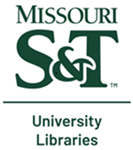Masters Theses
Abstract
"The primary objective of this study was to evaluate the trace organic contributions by two lead and zinc mining and milling operations in Southeastern Missouri. A secondary objective was to evaluate a reverse osmosis-solvent extraction method for use in recovering trace organics.
Trace organics were recovered in the first phase of the study following procedures as outlined by the American Society of Testing and Materials (ASTM), with chloroform and benzene being used as the solvents. The data indicated that the milling waste contained a larger concentration of trace organics than the excess mine water. Furthermore, it was shown that recycling the mill waste not only reduced the level of trace organics emitted for treatment, but also the level discharged to the receiving stream after treatment.
The second phase of the study utilized a tubular reverse osmosis unit and a simplified solvent extraction procedure. An oil leak from the high-pressure pump invalidated the results obtained on the concentrate waters. However, the low concentration of trace organics obtained from some of the product waters, with respect to the feed waters, indicated that the reverse osmosis unit may be capable of concentrating trace organics"-- Abstract, p. ii
Advisor(s)
Jennett, J. Charles
Committee Member(s)
Grigoropoulos, Sotirios G.
Gale, Nord L.
Department(s)
Civil, Architectural and Environmental Engineering
Degree Name
M.S. in Civil Engineering
Publisher
University of Missouri--Rolla
Publication Date
1975
Pagination
ix, 138 pages
Note about bibliography
Includes bibliographical references (pages 120-127)
Rights
© 1975 Alan James Callier, All rights reserved.
Document Type
Thesis - Open Access
File Type
text
Language
English
Thesis Number
T 4063
Print OCLC #
5984563
Recommended Citation
Callier, Alan James, "A study of trace organic emissions in mining and milling wastewaters in the new lead belt of southeastern Missouri." (1975). Masters Theses. 3025.
https://scholarsmine.mst.edu/masters_theses/3025


